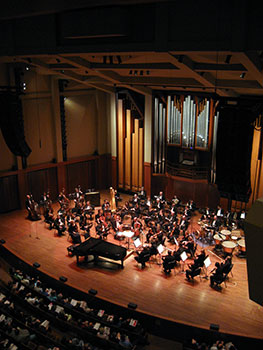Learn
- What is the Blues?
- Constructing a Blues Song
- The Early Blues
- Classic Blues
- A Modern Example
- W.C. Handy
- Father of the Blues
- Audience Etiquette

What is the Blues?
What classifies music as the blues? The blues is a musical form that originated from African American communities in the Deep South around the end of the 19th century. These African Americans were newly freed slaves that sang songs about the troubles and hardships of slavery. These songs were an important feature of the blues and because of this blues music usually sounds sad.
Watch the Blues Fundamentals with Tom Wolfe video (14:16) below.
Open Blues Fundamentals with Tom Wolfe in a new window
Note: The presentation may take a moment to load.

Constructing a Blues Song
The most common musical form of blues is the 12-bar blues. The term "12-bar" refers to the number of measures, or musical bars, used to express the theme of a typical blues song.
A 12-bar blues is divided into three four-bar segments. A standard blues progression, or sequence of notes, typically features three chords based on the first (written as I), fourth (IV), and fifth (V) notes of an eight-note scale. A chord is two or more notes played at the same time to create harmony.
The musical form of a 12-bar blues song is an AAB pattern.
- The first two sections or verses (AA) are four measures each and are similar. Often, the lyrics in the first and second lines are repeated.
- The last section (B) is also 4 measures long but sounds different. The third line lyrics are often a response to the lyrics in section AA, but with a twist.
- This is the basic form of the 12 bar blues.
To learn more, read Understanding the 12 Bar Blues and How to Write A Blues Song.
Watch the Let's Chat with Tom Wolfe! video (3:37) below to learn how a blues song is constructed.
Open Let's Chat with Tom Wolfe! in a new window
Note: The presentation may take a moment to load.

The Early Blues
After the Civil War, the blues developed even more. These early blues were known as the country blues. One person usually sang the blues and was accompanied by the following instruments: harmonica, guitar or banjo.
A fine example of the country blues is the song "Freight Train" by blues singer, Elizabeth "Libba" Cotten.
Watch the Origins and Influences of the Blues, featuring Dr. John Giggie video (3:42) below.
Open Origins and Influences of the Blues, featuring Dr. John Giggie in a new window
Note: The presentation may take a moment to load.

Classic Blues
The classic blues brought the new musical form to the forefront of the American scene. Ma Rainey began a tradition of more stylized blues-singing, complete with a back-up band that often included a saxophone, piano, trumpet, trombone, string (or double) bass, and drums.
The classic blues brought a rich African American musical tradition to the public's attention. The blues influenced a variety of other musical genres and became the fundamental root of rock and roll.
Watch the Blues Songs with Artist: BJ Reed video (6:59) below.
Open Blues Songs with Artist: BJ Reed in a new window
Note: The presentation may take a moment to load.

A Modern Example
Watch the Advanced Band Performance video (5:13) below to see Alabama high schoolers (just like you!) perform blues songs during the Alabama Blues Project Festival.
Open Advanced Band Performance in a new window
Note: The presentation may take a moment to load.

W.C. Handy
Review the W.C. Handy presentation below.
W.C. Handy fullscreen version | W.C. Handy text version
Note: The presentation may take a moment to load.

Father of the Blues
Watch the W.C. Handy: A Brief Portrait, featuring Dr. John Giggie video (9:35) below.
Open W.C. Handy: A Brief Portrait, featuring Dr. John Giggie in a new window
Note: The presentation may take a moment to load.

Audience Etiquette
When attending a public performance or production, or visiting a museum, gallery, or exhibit, the following rules of common courtesy should be observed in accordance with the rules of each given venue:
- Wear appropriate attire.
- Follow rules of the facility.
- Be attentive; refrain from talking and making inappropriate noises.
- Sit and become quiet when light or sound signals are given for performances. Remain quiet and seated during performances.
- If it is necessary for you to leave the auditorium, do so at intermissions or between musical selections. Never leave while the performance is going on.
- Applaud when appropriate. Show the cast and crew your appreciation for their hard work with applause. Do this when you like a song or dance or joke and at the end of the show.
- Refrain from touching works of art or production displays unless permitted.
- Refrain from photographing or videotaping performances or exhibits.
- Participate in all museum activities as directed by a docent or tour guide.
- Be aware of others when reviewing exhibits.
- Walk; do not run in museums, galleries, or performance halls.
- Speak quietly and avoid making loud noises in museums and galleries.
- Turn all electrical devices off or to silent mode during a performance.
- Avoid chewing gum and consuming food and drink during a performance and in an exhibition space.
- Do not place your feet on the seat in front of you or on the stage or the balcony rail.

The Seattle Symphony Orchestra on stage in Benaroya Hall. Image has been released into the public domain.

